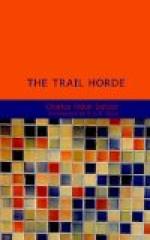CONCERNING MORALS
There were fifty thousand acres within view of the ranchhouse—virgin grass land dotted with sage, running over a wide level, into little hills, and so on to an upland whose rise was so gradual that it could be seen only from a distance, best from the gallery of the ranchhouse.
The first tang of autumn was in the sage-scented breeze that swept the county, and the tawny valley, basking in the warm sunlight that came down from a cloudless sky, showed its rugged beauty to advantage.
Kane Lawler paused at the edge of the gallery and filled his lungs from the sage-laden breeze, and then wheeled to face his mother.
She smiled at him.
“Have you seen Ruth Hamlin lately, Kane?”
Lawler’s lips opened, then closed again, tightly. And by that token Mrs. Lawler knew that something Kane had been on the point of saying never would be said. For she knew her son as no other person in the country knew him.
Kane Lawler was big. From the broad shoulders that bulged the gray flannel shirt, down the yellow corduroy trousers that encased his legs to the tops of the boots with their high heels and dull-roweled spurs, Lawler looked what he was, a man who asked no favors of his kind.
Mrs. Lawler had followed him out of the house, and she now stood near him, watching him.
There was in Lawler’s lean face as he turned from his mother and peered steadily out into the valley, a hint of volcanic force, of resistless energy held in leash by a contrary power. That power might have been grim humor—for his keen gray eyes were now gleaming with something akin to humor—it might have been cynical tolerance—for his lips were twisted into a curious, mirthless half-smile; it might have been the stern repression that had governed him all his days.
Whatever it was it seemed to be no secret from his mother, for she smiled understandingly, and with pride that must have been visible to anyone who watched her.
Massed in the big valley—at a distance of two or three miles from the big ranchhouse, was a herd of cattle. Circling them were a number of cowboys on horses. In the huge corral that spanned a shallow, narrow river, were other cattle. These were the result of the fall—or beef—round-up. For a month there had been intense activity in the section. Half the cattlemen in the county had participated in the round-up that had centered upon Lawler’s range, the Circle L: and the cattle had been herded down in the valley because of its natural advantages.
There the herd had been held while the neighboring cattlemen engaged in the tedious task of “cutting out”—which meant that each cattle owner took from the herd the steers that bore his “brand,” with the addition of a proportionate number of unbranded steers, and calves, designated as “mavericks.” Then the neighboring outfit had driven their stock home.




